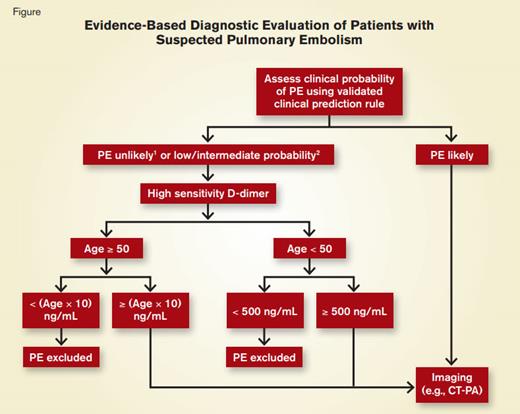Editor’s note
Data published in this article were presented in abstract form by Dr. Righini in the Late-Breaking Abstract Session of the 2013 ASH Annual Meeting in New Orleans.
A D-dimer concentration of < 500 µg/L measured using a high-sensitivity assay system is a robust means of excluding pulmonary embolism (PE) in patients with a low pretest probability of PE, as determined by a validated clinical prediction rule, obviating the need for imaging (e.g., CT-pulmonary angiography) in such patients. The positive predictive value of D-dimer values above this threshold, however, is less robust. D-dimer concentrations ≥ 500 µg/L are identified in 32 to 60 percent of patients who are suspected of, but ultimately determined to not have PE.1 Because steady-state D-dimer levels increase with age, using a fixed cutoff of 500 µg/L might overestimate the probability of PE in elderly patients and thereby explain, at least in part, the observed high percentage of false positive results. Dr. Marc Righini, of Geneva University Hospital in Geneva, Switzerland, and colleagues hypothesized that the use of an age-adjusted D-dimer cutoff might improve the specificity of D-dimer testing in older patients without compromising sensitivity. They defined the D-dimer cutoff for further evaluation as age multiplied by 10 in patients 50 years and older (e.g., in a 78-year-old patient, the age-adjusted cutoff would be 780 µg/L). A cutoff of 500 µg/L was retained for patients younger than 50 years. In the current study, this strategy, which was initially derived from three retrospective datasets,2 was tested in a prospective cohort of consecutive patients presenting to the emergency department with suspected PE. Patients were recruited from 19 centers in Belgium, France, the Netherlands, and Switzerland. The pretest probability of PE was estimated using the Simplified, Revised Geneva score or the two-level Wells score. Patients with a high or likely clinical probability score proceeded directly to imaging. In patients classified as low/intermediate or unlikely probability, a D-dimer test was measured using a high-sensitivity assay system. Patients with a D-dimer value above their age-adjusted cutoff proceeded to imaging, while those with a value below the age-adjusted threshold did not undergo imaging and were not treated with anticoagulation. (Figure) The primary outcome was symptomatic venous thromboembolism (VTE) at three months in patients with a D-dimer below the age-adjusted cutoff.
Evidence-Based Diagnostic Evaluation of Patients With Suspected Pulmonary Embolism. 1) Assessed using the 2-level Wells score. 2) Assessed using the Simplified, Revised Geneva Score.
Evidence-Based Diagnostic Evaluation of Patients With Suspected Pulmonary Embolism. 1) Assessed using the 2-level Wells score. 2) Assessed using the Simplified, Revised Geneva Score.
A total of 3,346 patients were enrolled in this study. Of these, the clinical probability was low/intermediate or unlikely in 2,898. A D-dimer < 500 µg/L was obtained in 817 patients. The D-dimer concentration was between 500 µg/L and the age-adjusted cutoff in an additional 337 patients. During the three-month follow-up period, symptomatic VTE occurred in one patient with a D-dimer < 500 µg/L (0.1% [95% CI: 0.0%-0.7%]) and in one patient with a D-dimer between 500 µg/L and the age-adjusted cutoff (0.3% [95% CI: 0.1%-0.7%]).
The age-adjusted cutoff was particularly useful in elderly patients (age ≥ 75 years). Of the 673 such patients with a low/intermediate or unlikely clinical probability, only 43 had a D-dimer < 500 µg/L. An additional 157 had a D-dimer concentration between 500 µg/L and their age-adjusted cutoff. None of these patients experienced symptomatic VTE during the three-month follow-up. Thus, compared with the traditional cutoff of 500 µg/L, the age-adjusted cutoff increased five-fold the proportion of elderly patients in whom PE could be safely excluded without imaging.
In Brief
This practice-changing study demonstrates that an age-adjusted D-dimer cutoff reliably excludes PE and reduces unnecessary imaging in older patients compared with a fixed cutoff of 500 µg/L. A revised diagnostic approach to patients with suspected PE that incorporates the findings of Dr. Righini and colleagues is shown in the Figure. In addition to age, D-dimer levels increase with surgery and malignancy. A D-dimer cutoff of 500 µg/L has notoriously poor specificity for PE in these settings. As we move away from a one-size-fits-all approach in elderly patients with suspected PE, one wonders whether use of a higher cutoff could also enhance the diagnostic specificity of the D-dimer for VTE in postoperative and cancer patients. Preliminary data are promising.3,4
References
Competing Interests
Dr. Cuker indicated no relevant conflicts of interest.

